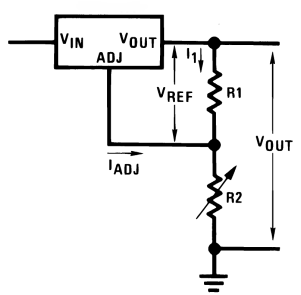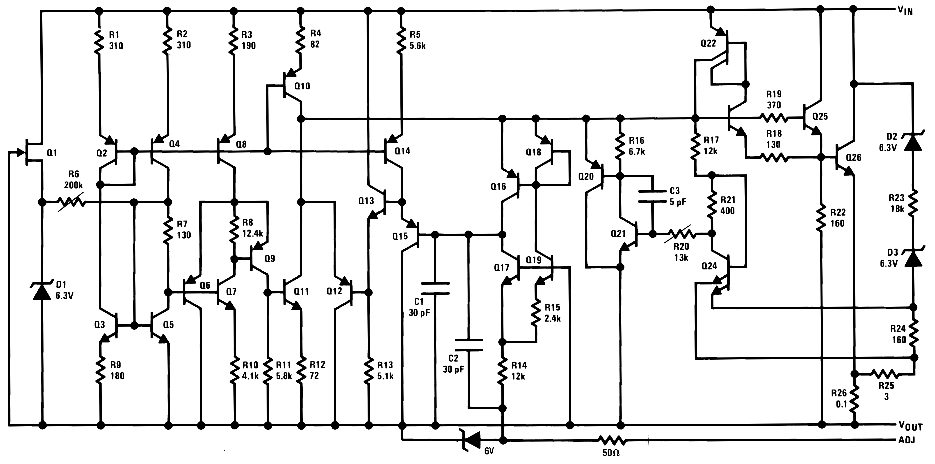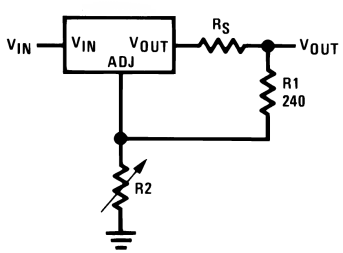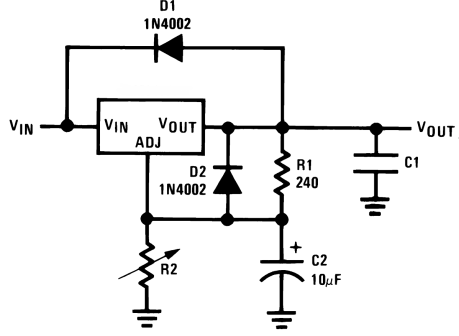SNVSAY0 June 2017 LM317-N-MIL
PRODUCTION DATA.
- 1 Features
- 2 Applications
- 3 Description
- 4 Revision History
- 5 Pin Configuration and Functions
- 6 Specifications
- 7 Detailed Description
-
8 Application and Implementation
- 8.1 Application Information
- 8.2
Typical Applications
- 8.2.1 1.25-V to 25-V Adjustable Regulator
- 8.2.2 5-V Logic Regulator With Electronic Shutdown
- 8.2.3 Slow Turnon 15-V Regulator
- 8.2.4 Adjustable Regulator With Improved Ripple Rejection
- 8.2.5 High Stability 10-V Regulator
- 8.2.6 High-Current Adjustable Regulator
- 8.2.7 Emitter-Follower Current Amplifier
- 8.2.8 1-A Current Regulator
- 8.2.9 Common-Emitter Amplifier
- 8.2.10 Low-Cost 3-A Switching Regulator
- 8.2.11 Current-Limited Voltage Regulator
- 8.2.12 Adjusting Multiple On-Card Regulators With Single Control
- 8.2.13 AC Voltage Regulator
- 8.2.14 12-V Battery Charger
- 8.2.15 Adjustable 4-A Regulator
- 8.2.16 Current-Limited 6-V Charger
- 8.2.17 Digitally Selected Outputs
- 9 Power Supply Recommendations
- 10Layout
- 11Device and Documentation Support
- 12Mechanical, Packaging, and Orderable Information
Package Options
Mechanical Data (Package|Pins)
- NDS|2
Thermal pad, mechanical data (Package|Pins)
Orderable Information
7 Detailed Description
7.1 Overview
In operation, the LM317-N-MIL develops a nominal 1.25-V reference voltage, VREF, between the output and adjustment terminal. The reference voltage is impressed across program resistor R1 and, because the voltage is constant, a constant current I1 then flows through the output set resistor R2, giving an output voltage calculated by Equation 1:

 Figure 15. Setting the VOUT Voltage
Figure 15. Setting the VOUT Voltage
Because the 100-μA current from the adjustment terminal represents an error term, the LM317-N-MIL was designed to minimize IADJ and make it very constant with line and load changes. To do this, all quiescent operating current is returned to the output establishing a minimum load current requirement. If there is insufficient load on the output, the output will rise.
7.2 Functional Block Diagram

7.3 Feature Description
7.3.1 Load Regulation
The LM317-N-MIL is capable of providing extremely good load regulation but a few precautions are needed to obtain maximum performance. The current set resistor, R1, must be connected near the output terminal of the regulator rather than near the load. If R1 is placed too far from the output terminal, then the increased trace resistance, RS, will cause an error voltage drop in the adjustment loop and degrade load regulation performance. Therefore, R1 must be placed as close as possible to the output terminal to minimize RS and maximize load regulation performance.
Figure 16 shows the effect of the trace resistance, RS, when R1 is placed far from the output terminal of the regulator. It is clear that RS will cause an error voltage drop especially during higher current loads, so it is important to minimize the RS trace resistance by keeping R1 close to the regulator output terminal.
 Figure 16. Regulator With Line Resistance in Output Lead
Figure 16. Regulator With Line Resistance in Output Lead
With the TO-3 package, it is easy to minimize the resistance from the case to the set resistor, by using two separate leads to the case. However, with the TO package, care must be taken to minimize the wire length of the output lead. The ground of R2 can be returned near the ground of the load to provide remote ground sensing and improve load regulation.
7.4 Device Functional Modes
7.4.1 External Capacitors
An input bypass capacitor is recommended. A 0.1-μF disc or 1-μF solid tantalum on the input is suitable input bypassing for almost all applications. The device is more sensitive to the absence of input bypassing when adjustment or output capacitors are used, but the above values will eliminate the possibility of problems.
The adjustment terminal can be bypassed to ground on the LM317-N-MIL to improve ripple rejection. This bypass capacitor prevents ripple from being amplified as the output voltage is increased. With a 10-μF bypass capacitor, 80-dB ripple rejection is obtainable at any output level. Increases over 10 μF do not appreciably improve the ripple rejection at frequencies above 120 Hz. If the bypass capacitor is used, it is sometimes necessary to include protection diodes to prevent the capacitor from discharging through internal low current paths and damaging the device.
In general, the best type of capacitors to use is solid tantalum. Solid tantalum capacitors have low impedance even at high frequencies. Depending upon capacitor construction, it takes about 25 μF in aluminum electrolytic to equal 1-μF solid tantalum at high frequencies. Ceramic capacitors are also good at high frequencies. However, some types have a large decrease in capacitance at frequencies around 0.5 MHz. For this reason, 0.01-μF disc may seem to work better than a 0.1-μF disc as a bypass.
Although the LM317-N-MIL is stable with no output capacitors, like any feedback circuit, certain values of external capacitance can cause excessive ringing. This occurs with values between 500 pF and 5000 pF. A 1-μF solid tantalum (or 25-μF aluminum electrolytic) on the output swamps this effect and insures stability. Any increase of the load capacitance larger than 10 μF will merely improve the loop stability and output impedance.
7.4.2 Protection Diodes
When external capacitors are used with any IC regulator, it is sometimes necessary to add protection diodes to prevent the capacitors from discharging through low current points into the regulator. Most 10-μF capacitors have low enough internal series resistance to deliver 20-A spikes when shorted. Although the surge is short, there is enough energy to damage parts of the IC.
When an output capacitor is connected to a regulator and the input is shorted, the output capacitor will discharge into the output of the regulator. The discharge current depends on the value of the capacitor, the output voltage of the regulator, and the rate of decrease of VIN. In the LM317-N-MIL, this discharge path is through a large junction that is able to sustain 15-A surge with no problem. This is not true of other types of positive regulators. For output capacitors of 25 μF or less, there is no need to use diodes.
The bypass capacitor on the adjustment terminal can discharge through a low current junction. Discharge occurs when either the input, or the output, is shorted. Internal to the LM317-N-MIL is a 50-Ω resistor which limits the peak discharge current. No protection is needed for output voltages of 25 V or less and 10-μF capacitance. Figure 17 shows an LM317-N-MIL with protection diodes included for use with outputs greater than 25 V and high values of output capacitance.

 |
||
| D1 protects against C1 | ||
| D2 protects against C2 | ||